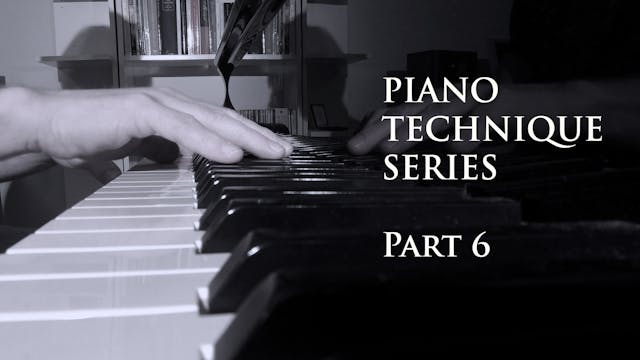-
Piano Technique: Playing chords with weight
Playing chords with weight, not muscle tension. It includes how to lift the arm and how to use the wrist, the fingers etc. to coordinate the weight and create good sound quality.
-
Piano Technique. Arm and hand placement
How to place the arm and hand properly, both regarding knuckles, palms, fingers, elbows and more.
-
Piano Technique: About the thumb
The thumb is a unique finger that requires special attention. In this episode I talk about how to move the thumb, and some exercises to develop the thumb as well as take away tension, which are often present in dealing with the thumb.
-
Piano Technique: Playing a scale (Part 2)
On playing a scale and how to turn on the fifth finger, how to adjust the finger in different tonalities and some wise words on your every day practice.
-
Piano Technique Introduction
Why do we need good technique? What is the purpose and how does one approach practicing technique?
-
PIano Technique: Playing a scale (1)
How to play a scale: handposition, movements of the fingers, the thumb and also the right way to use the wrist.
-
Piano Technique: How to sit at the piano
Walking through how to sit at the piano in a way that can maximize your technical abilities as well as permit you to practice for many hours a day without getting pains in lower back, neck and other spots.
-
Piano Technique: How to move the fingers
Explanation on how to move the fingers (except the thumb, which is very different and is the topic for the next episode), how the muscles related to lifting fingers should be activated, and some ways of lifting the fingers that are NOT advisable.
-
Lesson: "Appassionata": first movement: Exposition to end
-
Lesson: "Appassionata": Introduction & Beginning
-
Lesson: "Appassionata": second movement
-
Lesson: "Appassionata": third movement
-
Lesson: "Pathétique Sonata" first movement
-
Lesson: "Pathétique Sonata"second movement
-
Lesson: The "Pastoral Sonata" Op. 28 1st movement
It's delicate to find the right amount of drama and tension in this movement. A lot of attention has to be directed towards the slurs and the articulation, and the technical aspects of how to bring out the needed phrasing and articulation.
-
Lesson: The "Pastoral Sonata" Op. 28 2nd movement
About the second movement of Sonata D-major Op. 28, the so-called "Pastoral Sonata". There is a lot of string writing in this movement, which creates challenges technically so that the appropriate articulation is heard.
-
Lesson: The "Pastoral Sonata" Op. 28 3rd movement
About the second movement of Sonata D-major Op. 28, the so-called "Pastoral Sonata". Again, articulation is very important as well as choices of tempo and phrasing.
-
Lesson: The Op. 3 No. 2 1st movement
This sonata is a big work, with lots of brilliance and virtuosity. There are lot of technical challenges.
-
Lesson: The Op. 3 No. 2 2nd movement
As the most dramatic movement of the sonata, the Adagio finds inspiration in Opera Seria. The emotional storytelling is important. Also talked about is phrasing, pedalling and articulation in order to get the desired musical effects.
-
Lesson: The Op. 3 No. 2 3rd and 4th movements.
The third and fourth movements of Sonata C-Major Op. 2 No. 3 pose considerable technical difficulties. The musical discourse is a bit different in the finale as the music feels more spontaneous and quasi-improvised.
-
Music&Conversation: Edvard Grieg
Edvard Grieg's music is loved all over the world. The first episode of "Music&Conversation", presents the life and music of the Norwegian composer. Included in the program are 7 Lyric Pieces, from Wilhelm Stenhammar's first Piano Concerto, Liszt's "Leibestraum", and Grieg's greatest work for ...
-
Lesson: Claire De Lune - interpretation
Talking about Claude Debussy's Claire De Lune, history, concept, character, phrasing, sound etc.
-
Lesson: Clair de Lune - How to learn























